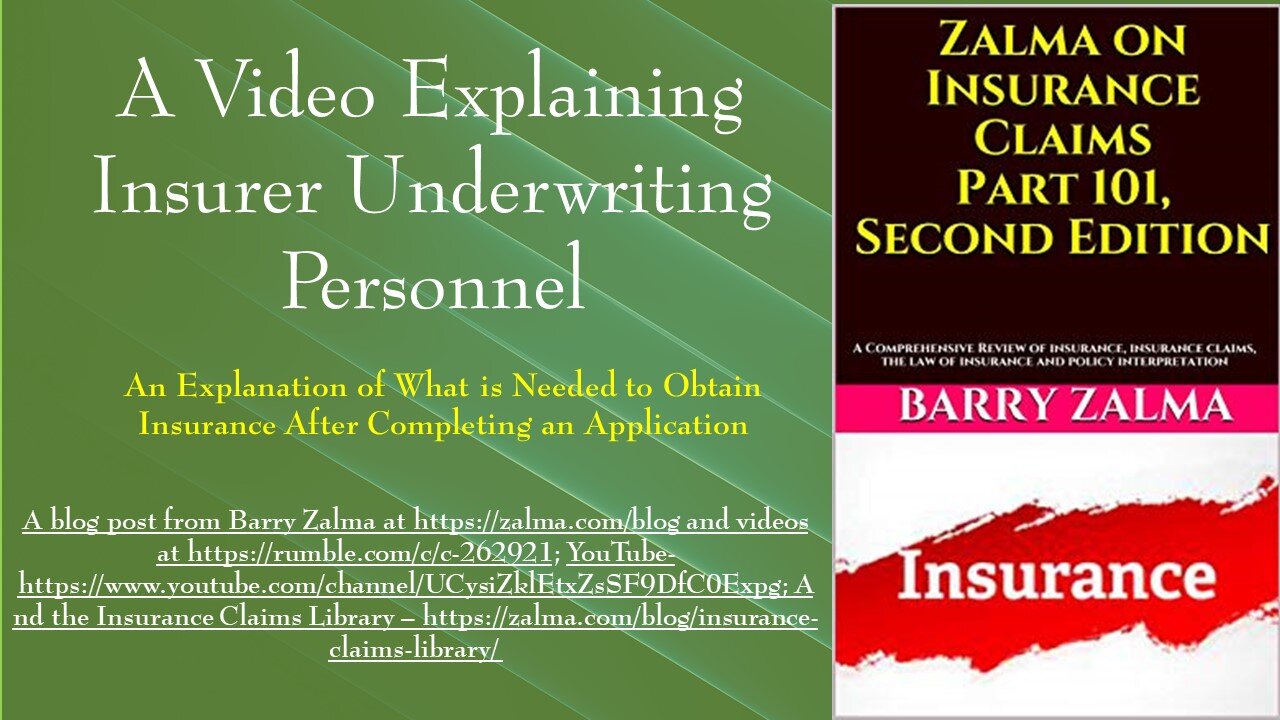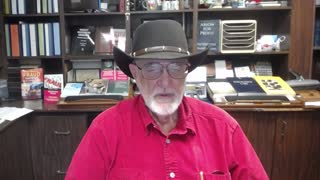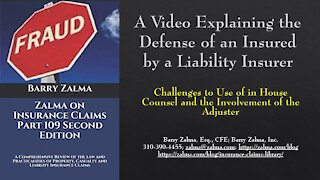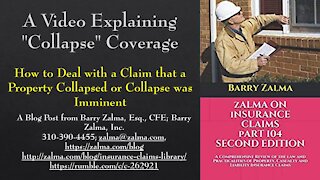Premium Only Content

A Video Explaining Insurer Underwriting Personnel
An Explanation of What is Needed to Obtain Insurance After Completing an Application
The Underwriter
The person who makes the decision to insure or not insure a prospective insured, in modern practice, is called an underwriter. Unlike the original underwriters at Lloyd’s the person with the title “underwriter” is usually an employee of an insurer who was employed to evaluate risks the insurer employer is willing to take.
The agent or broker deals directly with the insurer’s underwriter or an agent appointed by the insurer to act as its underwriter. The agent and broker try to present the risk to the insurer and underwriter best suited for the risk.
The underwriter is the risk taker. He or she decides whether the risk presented by the broker or agent is the type of risk that the insurer is willing to take. Each insurer has specialized underwriters who look at risks differently and use their own criteria to evaluate them.
The Loss Prevention Engineer
If the risk the prospective insured proposes is large, he or she will often be visited by a loss prevention engineer. This person, employed by the insurer, is obligated to inspect the prospective insured’s real and personal property and to interview him or her to ascertain that the insured and the property meet the requirements the insurer insists upon before it will accept a risk for insurance.
The Pre-Risk Inspection Service
If the risk is residential or a specialty type of business the insurer will have it inspected by a specialized company called a “pre‑risk inspection service.” Its inspectors are often experienced claims adjusters who understand the types of hazards faced by prospective insureds and their prospective insurers. The pre‑risk inspection service seeks much the same information for the insurer as the loss prevention engineer. In addition, it determines if there is any specialized information needed by the insurer because of the type of risk.
After the policy comes into effect the insured should have no contact with the insurer except when it comes time to renew the insurance or pay premium. At the time of renewal the insured may see the same people he or she saw to acquire the policy or no one at all. If the insured has presented no claims during the policy term he or she may merely receive an offer from the insurer to renew the insurance for a specified premium. The insured will either accept the offer or find insurance with another insurer at a better price.
© 2021 – Barry Zalma
Barry Zalma, Esq., CFE, now limits his practice to service as an insurance consultant specializing in insurance coverage, insurance claims handling, insurance bad faith and insurance fraud almost
equally for insurers and policyholders. He also serves as an arbitrator or mediator for insurance related disputes. He practiced law in California for more than 44 years as an insurance coverage and claims handling lawyer and more than 52 years in the insurance business. He is available at http://www.zalma.com and zalma@zalma.com.
Mr. Zalma is the first recipient of the first annual Claims Magazine/ACE Legend Award.
Over the last 53 years Barry Zalma has dedicated his life to insurance, insurance claims and the need to defeat insurance fraud. He has created the following library of books and other materials to make it possible for insurers and their claims staff to become insurance claims professionals.
Go to the podcast Zalma On Insurance at https://anchor.fm/barry-zalma; Follow Mr. Zalma on Twitter at https://twitter.com/bzalma; Go to Barry Zalma videos at Rumble.com at https://rumble.com/c/c-262921; Go to Barry Zalma on YouTube- https://www.youtube.com/channel/UCysiZklEtxZsSF9DfC0Expg; Go to the Insurance Claims Library – https://zalma.com/blog/insurance-claims-
library/ Read posts from Barry Zalma at https://parler.com/profile/Zalma/posts; and Read last two issues of ZIFL here.
-
 8:36
8:36
Barry Zalma, Inc. on Insurance Law
11 months agoZalma's Insurance Fraud Letter - January 15, 2024
240 -
 16:01
16:01
Barry Zalma, Inc. on Insurance Law
4 years agoA Video Explaining the Underwriting Concerns About Unacceptable Risks
113 -
 17:29
17:29
Barry Zalma, Inc. on Insurance Law
4 years agoA Video Explaining the Nature of Insurance Underwriting
34 -
 17:44
17:44
Barry Zalma, Inc. on Insurance Law
3 years agoA Video Explaining The Creation of Insurance and the Ethical Insurer
44 -
 16:05
16:05
Barry Zalma, Inc. on Insurance Law
4 years agoA Video Explaining the Defense of an Insured by a Liability Insurer
41 -
 17:01
17:01
Barry Zalma, Inc. on Insurance Law
3 years agoA Video Explaining "Collapse" Coverage
158 -
 18:36
18:36
Barry Zalma, Inc. on Insurance Law
3 years agoA Video Explaining More Construction Defects
95 -
 15:00
15:00
Barry Zalma, Inc. on Insurance Law
4 years agoA Video Explaining The Need For Training Professional Insurance Claims Personnel
63 -
 16:51
16:51
Barry Zalma, Inc. on Insurance Law
3 years agoA Video Explaining the Structure of Insurance
122 -
 16:55
16:55
Barry Zalma, Inc. on Insurance Law
4 years agoA Video Explaining Intentional Acts Exclusions
72